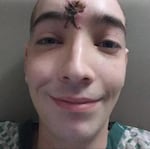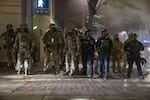It’s been nearly 14 months since federal law enforcement officers shot Donavan LaBella in the face with a less lethal munition while he was peacefully protesting outside the federal courthouse in downtown Portland.
Now, he’s homeless, living in a tent, and the U.S. Department of Justice is conducting a criminal investigation of the incident, OPB has learned. Last year, the agency’s Office of Inspector General announced an investigation into use of force allegations by DOJ law enforcement officers in Portland during July 2020. But the nature of the investigation has not been known.
Video uploaded to social media from July 11, 2020, shows LaBella holding a speaker over his head, pointed at the courthouse. Federal officers stand outside the building. One turned on a bright light. A moment later, an officer fired a less lethal munition. It struck LaBella in the face. His body collapsed onto the street. A crowd of protesters rushed to his aid.
“He does have a traumatic brain injury,” said Desiree LaBella, Donavan’s mother. “His ability to reason and impulse control are still impaired. He’s still currently homeless … couch hopping for the last few months and currently living in a tent.”
LaBella’s attorneys said he’s suffered permanent brain damage that one specialist equated to a frontal lobotomy.

Donavan LaBella, 26, was shot in the head by a U.S. Marshal and suffered a frontal lobe skull fracture during protests against racism and police violence in Portland. Two weeks later, before being released from the hospital, his mom said he still had cognitive problems and struggles with impulse control.
Courtesy of the family
The family intends to file a lawsuit. But, like many other cases from the summer of extended protests, that lawsuit may not be a clear path to finding accountability for the government’s actions.
Numerous lawsuits have been filed in the wake of the federal response to racial justice protests in Portland. As the widespread police violence of the summer has faded, many of those have stalled; others ended in dismissal. None have led to any long-term changes that would prevent a similar response in the future.
While the hundreds of federal officers deployed to the city have moved on, many protesters who were injured in clashes with those officers have not. LaBella is one of several protesters who still don’t know the names of the officers they say injured them.
Throughout the last year, prosecutors with the U.S. Department of Justice’s Office of Civil Rights Criminal Section in Washington D.C. have been in communication with LaBella’s attorneys.
“They want to interview Donavan, but Donavan is not really in a position to be giving statements at the moment,” said James Healy, one of LaBella’s attorneys. “We actually met with one of the attorneys when she was in Oregon for other work to provide her with Donavan’s medical records and have a discussion with her about the criminal case.”
A spokeswoman with the DOJ’s Office of Inspector General declined to comment.
Healy said they don’t know the identity of the officer, or officers, responsible. They also don’t know with certainty the federal law enforcement agency that employs the officer, or officers. Federal prosecutors, Healy said, haven’t provided them with much information.
“They gave us some vague statement that they have identified someone, but it was kind of like they’ve identified a subject or something to that effect, but won’t tell us who it is,” Healy said.
Last summer, Oregon’s Congressional delegation said the officer was part of the U.S. Marshals Service’s Special Operations Group, which the delegation noted maintains a small cadre at the agency’s tactical operation center at Camp Beauregard, Louisiana. Emails from leaders at the Department of Homeland Security also indicate the officer was not with the Federal Protective Service, the agency responsible for protecting federal facilities.
“This Twitter post has very clear video of the weapon deployment,” one redacted email stated to a senior Federal Protective Service official. “It’s not an FPS operator.”
Unnamed officers
Difficulties identifying officers who acted violently at last summer’s protests are not restricted to the LaBella case.
Two weeks after LaBella was hurt, Erika Clark said she was peacefully protesting when she was shot in the hand by a munition and later pushed by two federal officers while she was complying with their directions.
“A third officer comes up and he rips off my mask and he rips off my goggles,” Clark said.
Then, she said, the officer sprayed her in the face and mouth with mace.
“And I remember being just livid,” Clark said. “And like, ‘protect and serve who, who?’” The experience left Clark shaken and traumatized.

Erika Clark says she was injured by federal law enforcement officers during the early morning hours of July 26, 2020, in downtown Portland.
Courtesy of Erika Clark
In court filings, government attorneys have pushed back against releasing the names of the federal officers deployed to Portland over concerns about their privacy and safety.
That’s made it harder for civil rights lawyers who are representing injured protesters to move forward with some of the most basic legal steps. Instead of naming the officers in the lawsuits by name, attorneys have had to list John Does.
“Why can’t you set the example and be accountable?” said Erious Johnson, an attorney who represents two different protesters who were seriously hurt from tear gas canisters fired by federal officers. “Why are you forcing individuals to search for accountability?”
Johnson argues the Justice Department has employed a delay tactic to slow the legal process down.
“It is to solely reduce the importance of what happened here. What happened is the government overreached,” Johnson said. “Our government came in and did this to its people. If we just forget about it, it will happen again.”
For the last year, U.S. Sen. Ron Wyden, D-Oregon, has repeatedly asked the Department of Homeland Security and the Justice Department questions about the deployment of federal officers.
“I’m very troubled by the issues that underlie this,” Wyden told OPB.
So far, he said his questions have largely gone unanswered. He believes agencies are redacting information people should have access to.
“This is a fundamental question of transparency, and accountability with respect to what was done under the policies of the Trump administration where they deployed federal officials in our city,” Wyden said.
In response to the stonewalling, Wyden has held up President Biden’s nominee to run Customs and Border Protection, one of agencies that responded to last summer’s protests. Wyden has also asked about whether the officer, or officers, who shot LaBella have been investigated or disciplined.
“Questions about the shooting of this peaceful protester by the federal troops dispatched last year by Donald Trump to Portland are among my inquiries requiring accountability and answers from the Departments of Justice and Homeland Security,” Wyden said. “And I’m going to keep pressing those federal agencies until I am satisfied that justice is done.”
Accountability
The Department of Homeland Security’s Office of Inspector General found more than 750 DHS officers were part of the federal government’s response to the monthslong protests — many of whom were not trained to do crowd control. Officers reported hundreds of injuries.
The Justice Department also surged FBI agents and U.S. marshals to Portland as part of the federal government’s response.

Federal law enforcement officers, along with PPB, dispersed hundreds of protesters from the Justice Center and federal courthouse on the 4th of July during protests against systemic racism and police violence. Protesters ate food, danced, burned American flags and set off fireworks before Portland police and federal law enforcement used tear gas and impact munitions to disperse the crowd.
Jonathan Levinson / OPB
“Clearly there was a duty to respond,” said Renn Cannon, the former Special Agent In Charge of the FBI’s Portland office during the protests. He retired in January.
Cannon said last summer was unprecedented in the city. While the vast majority of protesters were peacefully exercising their rights, there was a smaller group intent on property destruction, he said. It was challenging for law enforcement to navigate that environment, night after night.
“Whether or not there were mistakes made by individuals or there was an overstepping of authorities is something that we’re sorting out now,” Cannon said. “When the facts come to light, people are going to look at it and say, ‘well, that was reasonable and that was within federal authorities.’”
Some attorneys who have sued the federal government remain frustrated with how challenging it’s been to move cases forward.
Kelly Simon, legal director with the ACLU of Oregon, argues the Justice Department is trying to avoid accountability for last summer. That approach, she said, risks the possibility of not answering key questions about whether the federal government and law enforcement officers exceeded their authority.
“That’s what I’d like to see from our leaders, from government officials, is the willingness to just reckon with what happened last year,” Simon said.
That could go a long way with some protesters who have endured long physical and emotional recoveries.
“We want him to be OK, first and foremost,” Desiree LaBella said of her son. “We want him to be back to his old self. We want him not living in a tent.”
LaBella said whoever pulled the trigger should have to come forward publicly and account for what happened.
“If they’re not held accountable, then in the future they’re going to think that they don’t have to be held accountable for their actions,” Desiree LaBella said. “Legally speaking, one armed person shot another unarmed person. And they need to be legally, and morally, held accountable for those actions.”
For Clark, who was also injured by law enforcement during a protest last July, accountability is also part of getting closure.
“My dignity as a person was literally stripped from me that day by three federal agents,” Clark said. “And now we have a justice system that is keeping us from getting this information and from holding them accountable.”





